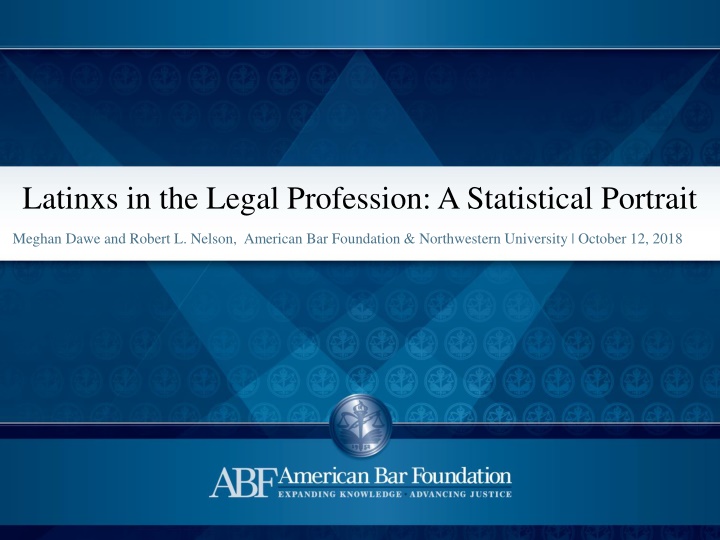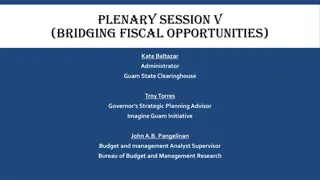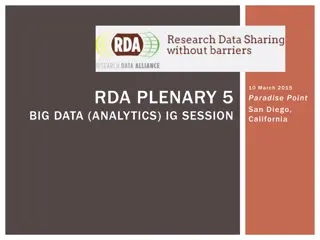
Latinxs in the Legal Profession: Statistical Portrait and Findings
Explore the statistical portrait of Latinxs in the legal profession, highlighting rising numbers, educational progress, social disparities, and experiences within the legal profession. The data includes insights on demographics, nativity, geographical distribution, and career satisfaction among Latinx individuals in the United States.
Download Presentation

Please find below an Image/Link to download the presentation.
The content on the website is provided AS IS for your information and personal use only. It may not be sold, licensed, or shared on other websites without obtaining consent from the author. If you encounter any issues during the download, it is possible that the publisher has removed the file from their server.
You are allowed to download the files provided on this website for personal or commercial use, subject to the condition that they are used lawfully. All files are the property of their respective owners.
The content on the website is provided AS IS for your information and personal use only. It may not be sold, licensed, or shared on other websites without obtaining consent from the author.
E N D
Presentation Transcript
Latinxs in the Legal Profession: A Statistical Portrait e Meghan Dawe and Robert L. Nelson, American Bar Foundation & Northwestern University | October 12, 2018
AJD Mid-Career Satisfaction Overview of Presentation and Findings 1. Selected Demographics on Latinx in United States Rising numbers, rising numbers of born in U.S., regional variation in country of origin: New York and Miami very different from other areas, generational progress in education and college degrees, but continuing social disadvantages reflected in lower household income and higher poverty rates than whites and Asian Americans. Would Respondents Still Attend Law School? 80% 70.2% 68.6% 70% 61.7% 60.1% 58.0% 60% 50% 2. Latinx in Legal Profession Part I Public Data 42.0% 39.9% 38.3% 40% 31.4% 29.8% Problems with the pipeline to law school and law practice; underrepresentation in law firm partnerships; growing representation among law students, Article III judges, and law faculty. 30% 20% 10% 0% 3. Latinx in Legal Profession Part II After the JD Study of Lawyer Careers African American Latino Asian American White Total Yes No Experience within legal profession looks positive in terms of law school credentials, entry to practice settings, earnings, satisfaction but still have higher levels of self-reported discrimination in workplace.
AJD Mid-Career Satisfaction Figure 2: Nativity of Latinx Population, 1980-2015 60,000,000 56,476,777 50,729,570 50,000,000 Would Respondents Still Attend Law School? 80% 70.2% 68.6% 40,000,000 37,048,766 70% 35,204,480 61.7% 60.1% 58.0% 31,908,900 60% 30,000,000 50% 42.0% 39.9% 38.3% 40% 31.4% 29.8% 21,836,851 21,087,484 20,000,000 30% 14,775,080 19,428,011 18,820,670 20% 14,116,996 14,041,095 10% 10,000,000 10,593,732 0% Latino 7,795,756 African American 4,181,348 1980 Asian American White Total 0 Yes No 1990 2000 2010 Total 2015 Foreign-born U.S.-born Source: Pew Research Center tabulations of 1980, 1990, 2000 censuses (5% IPUMS) and 2010 and 2015 American Community Surveys (1% IPUMS) Statistical Portrait of Hispanics in the United States, 1980-2015.
AJD Mid-Career Satisfaction Nativity of Latinx Population by Geographic Region Would Respondents Still Attend Law School? -the composition of the Latinx population varies significantly by region 80% 70.2% 68.6% 70% 61.7% 60.1% -in the Northeast, Puerto Ricans account for over one-third of the Latinx population and South Americans, Central Americans, and Dominicans combined account for nearly half 58.0% 60% 50% 42.0% 39.9% 38.3% 40% 31.4% 29.8% 30% -in Miami, Cubans and non-Latins each make up more than one-third of the Latinx population 20% 10% 0% African American Latino Asian American White Total -in California, 84% of the Latinx population is of Mexican origin; and in Illinois, 80% of the Latinx population is of Mexican origin Yes No
AJD Mid-Career Satisfaction Figure 7: Latinx Population across U.S. Counties, 2014 Would Respondents Still Attend Law School? 80% 70.2% 68.6% 70% 61.7% 60.1% 58.0% 60% 50% >=100,000 42.0% 39.9% 38.3% 40% 31.4% 29.8% 50,000 - 99,999 30% 20% 10,000 - 49,999 10% 1,000 - 9,999 0% African American Latino Asian American White Total <1,000 Yes No Source: Pew Research Center. Hispanic Population Growth and Dispersion across U.S. Counties, 1980-2014.
AJD Mid-Career Satisfaction Figure 9: Educational Attainment (25 and older), 1980-2015 78.4% 1980 13.9% 7.7% 71.7% Would Respondents Still Attend Law School? 1990 19.2% 9.1% 80% 70.2% 68.6% 70% 69.6% 61.7% 2000 60.1% 19.9% 58.0% 60% 10.5% 50% 42.0% 64.1% 39.9% 38.3% 2010 40% 22.8% 31.4% 13.1% 29.8% 30% 61.4% 20% 2015 23.6% 15.0% 10% 0% 0% African American 10% High School Graduate or Less Bachelor's Degree or More 20% 30% Asian American 40% 50% 60% 70% 80% Latino White Total Yes No Two-year Degree/Some College Source: Pew Research Center tabulations of 1980, 1990, 2000 censuses (5% IPUMS) and 2010 and 2015 American Community Surveys (1% IPUMS). Statistical Portrait of Hispanics in the United States, 1980- 2015.
AJD Mid-Career Satisfaction Figure 10: Median Household Income by Race-Ethnicity (2015 Dollars) $80,000 $77,000 $72,836 $71,595 $70,000 Would Respondents Still Attend Law School? $64,678 $61,957 80% 70.2% 68.6% $60,000 70% $61,000 $54,805 61.7% 60.1% $58,704 58.0% 60% $54,639 $50,000 50% 42.0% $43,835 $44,800 39.9% $43,484 38.3% $48,806 $42,227 40% 31.4% 29.8% $40,000 30% $36,751 $39,928 20% $36,201 $36,000 $33,782 10% $30,000 $29,848 0% African American Latino Asian American White Total $20,000 Yes No 1980 1990 2000 2010 2015 Latinx African American Asian American White Source: Pew Research Center tabulations of 1980, 1990, 2000 censuses (5% IPUMS) and 2010 and 2015 American Community Surveys (1% IPUMS). Statistical Portrait of Hispanics in the United States, 1980- 2015.
Figure 11: Percentage of Latinxs Living in Poverty, 1980-2015 AJD Mid-Career Satisfaction 35% 29.4% 29.0% 30% 26.9% Would Respondents Still Attend Law School? 24.7% 24.7% 80% 25% 70.2% 68.6% 24.9% 70% 24.7% 61.7% 60% 23.2% 60.1% 22.5% 58.0% 20% 21.9% 50% 42.0% 39.9% 15% 38.3% 13.4% 40% 12.5% 12.4% 12.2% 31.4% 11.5% 29.8% 30% 10% 20% 10.6% 9.8% 8.9% 8.7% 8.1% 10% 5% 0% African American Latino Asian American White Total 0% Yes No 1980 Latinx 1990 2000 2010 2015 African American Asian American White Source: Pew Research Center tabulations of 1980, 1990, 2000 censuses (5% IPUMS) and 2010 and 2015 American Community Surveys (1% IPUMS). Statistical Portrait of Hispanics in the United States, 1980-2015.
AJD Mid-Career Satisfaction Would Respondents Still Attend Law School? 80% 70.2% 68.6% 70% 61.7% 60.1% 58.0% 60% 50% 42.0% 39.9% 38.3% 40% 31.4% 29.8% From Latinxs Overall to Latinx Lawyers 30% 20% 10% 0% African American Latino Asian American White Total Yes No
Figure 17: Pipeline from College to Law School to Legal Employment: Educational and Employment Characteristics by Race-Ethnicity % High School Graduates % of Degrees Awarded by Employment Status Class of 2014 (NALP 2015) % of College Graduates % General Population % of ABA Enrollment % of ABA Applicants ABA Law Schools Bar Passage Rate Other Professional Three Years After the Bar Seven Years After the Bar Twelve Years After the Bar Total Employed JD Preferred JD Required Race/ Ethnicity Latinx 17.3% 20.2% 10.5% 10.3% 12.6% 11.9% 87.7% 3.7% 4.7% 3.2% African American 82.8% 59.9% 16.9% 4.7% 12.3% 14.6% 10.8% 14.3% 10.1% 8.8% 77.6% 5.5% 6.3% 4.4% Asian American 5.6% 5.7% 7.3% 10.9% 7.4% 7.3% 91.9% 6.7% 7.0% 6.3% White 61.1% 56.6% 68.8% 63.7% 69.9% 68.3% 96.7% 88.2% 68.5% 14.1% 4.1% 84.0% 82.1% 82.8%
Figure 18: Racial-Ethnic Minority Representation in the Legal Profession 18% 16% 14% 4.4% 4.7% 12% 4.8% 5.1% 4.2% 4.3% 10% 5.6% 8% 4.4% 4.6% 4.2% 4.4% 6% 5.3% 4% 5.6% 5.6% 5.1% 5.1% 2% 4.0% 3.2% 0% 2011 2012 2013 2014 2015 2016 Latinx African American Asian American Source: Bureau of Labor Statistics, 2016. Institute for Inclusion in the Legal Profession. - 11-
Figure 20: Latinx Law School Enrollment, 2011-12 through 2017-18 Latinx as Percentage of Total JD Enrollment Academic Year Latinx JD Enrollment Total JD Enrollment 2011-12 11,056 144,482 7.7% 2012-13 11,323 137,210 8.3% 2013-14 11,215 126,627 8.9% 2014-15 11,314 117,806 9.6% 2015-16 11,421 111,883 10.2% 2016-17 11,667 109,132 10.7% 2017-18 12,067 108,286 11.1% Source: Steve Daniels Calculations of Data from Standard 509 Disclosures submitted to the American Bar Association.
Figure 21: Associate Demographics by Race-Ethnicity and Gender Latinx African American Asian American White Women % Women % Women % Women % Total % Total % Total % Total % 20091 3.9 2.0 4.7 2.9 9.3 5.1 80.3 45.7 20132 3.8 1.9 4.1 2.4 10.5 5.6 79.1 44.8 20143 4.0 1.9 4.0 2.3 10.8 5.8 78.4 44.9 20154 4.3 2.0 4.0 2.3 10.9 6.0 78.0 44.7 20165 4.4 2.2 4.1 2.3 11.3 6.4 80.2 n/a 20176 4.6 2.2 4.3 2.4 11.4 6.5 79.8 n/a 1National Association for Legal Professionals Bulletin (January 2010) 2 National Association Legal Professionals Bulletin (February 2014) 3 National Association for Legal Professionals Press Release (December 11, 2013) 4 National Association for Legal Professionals Bulletin (May 2015) 5 National Association Legal Professionals Bulletin (January 2016) 6 National Association for Law Placement Report on Diversity (December 2017) - 11-
Figure 22: Partner Demographics by Race-Ethnicity and Gender African American Total % Latinx Asian American White Total % Women % Women % Total % Women % Women % Total % 20091 1.7 0.4 1.7 0.6 2.2 0.7 94.0 19.2 20132 2.0 0.5 1.8 0.6 2.7 0.9 93.0 20.2 20143 2.2 0.6 1.7 0.6 2.7 1.0 92.7 21.1 20154 2.2 0.6 1.8 0.6 2.9 1.1 92.5 21.5 20165 2.3 0.7 1.8 0.6 3.1 1.2 92.8 n/a 20176 2.4 0.7 1.8 0.7 3.3 1.2 92.5 n/a 1 National Association for Legal Professionals Bulletin (January 2010) 2 National Association Legal Professionals Bulletin (February 2014) 3 National Association for Legal Professionals Press Release (December 11, 2013) 4 National Association for Legal Professionals Bulletin (May 2015) 5 National Association Legal Professionals Bulletin (January 2016) 6 National Association for Law Placement Report on Diversity (December 2017) - 11-
Figure 24: Article III Judges by Race-Ethnicity 7% 11% 2% 80% Latinx African American Asian American White Source: Alliance for Justice, Judicial Selection Snapshot 2017. Institute for Inclusion in the Legal Profession. - 11-
AJD Mid-Career Satisfaction After the JD (AJD) - Research Design Nationally representative sample of lawyers in the US who began practice in the year 2000 A three-wave longitudinal design AJD1: 2003; AJD2: 2007; AJD3: 2012 (data collection underway) 18 sampling units from three tiers of legal markets Major: > 2,000 new lawyers (4 sampling units: NYC, DC, Chicago, LA) Large: 750 2,000 new lawyers (5 sampling units, e.g., Boston, St. Louis) Small: the remaining 9 sampling units (e.g., Connecticut, eastern half of Tennessee) Minority Oversample (African American, Hispanics, Asian American) High Response Rates: Wave 1 71%; Wave 2 75% of Wave 1 respondents, 51% overall Would Respondents Still Attend Law School? 80% 70.2% 68.6% 70% 61.7% 60.1% 58.0% 60% 50% 42.0% 39.9% 38.3% 40% 31.4% 29.8% 30% 20% 10% 0% African American Latino Asian American White Total Yes No
AJD Mid-Career Satisfaction Figure 26: AJD Racial-Ethnic Distribution of Sample 10.0% Would Respondents Still Attend Law School? 80% 70.2% 68.6% 10.4% 70% 61.7% 60.1% 58.0% 60% 50% 42.0% 39.9% 10.4% 38.3% 40% 31.4% 29.8% 30% 69.2% 20% 10% 0% African American Latino Asian American White Total Yes No Latinx African American Asian American White
AJD Mid-Career Satisfaction Figure 27: AJD Gender by Race-Ethnicity Latinx 47.5% 52.5% Would Respondents Still Attend Law School? 80% 70.2% 68.6% 70% African American 59.4% 40.6% 61.7% 60.1% 58.0% 60% 50% 42.0% 39.9% 38.3% 40% Asian American 31.4% 29.8% 52.8% 47.2% 30% 20% 10% White 44.7% 55.3% 0% African American Latino Asian American White Total Yes No 0% 20% 40% 60% 80% 100% Women Men
AJD Mid-Career Satisfaction AJD Social Background by Race-Ethnicity -Latinx respondents come from less privileged social backgrounds than other racial-ethnic groups Would Respondents Still Attend Law School? 80% -Latinx and Asian American respondents have the highest proportion of foreign-born fathers (56.7% and 87.4%, respectively); nearly all fathers of white respondents were born in the United States (91.8%) 70.2% 68.6% 70% 61.7% 60.1% 58.0% 60% 50% 42.0% 39.9% 38.3% 40% -fathers of Latinx respondents have the lowest education levels; 36.8% have a high school diploma or less and 34.2% have attended graduate or professional school 31.4% 29.8% 30% 20% 10% 0% -fathers of Latinx respondents also work in the least prestigious occupations, followed closely by fathers of African American respondents; 23.1% are managers and 26.5% are blue collar workers African American Latino Asian American White Total Yes No
AJD Mid-Career Satisfaction Figure 31: AJD Law School Ranking by Race-Ethnicity Latinx 14.1% 13.3% 19.6% 30.0% 11.7% 11.3% Would Respondents Still Attend Law School? 80% 70.2% 68.6% 9.8% African American 15.7% 22.6% 21.9% 14.4% 15.6% 70% 61.7% 60.1% 58.0% 60% 50% 42.0% 21.7% 39.9% 38.3% Asian American 16.1% 17.8% 26.5% 9.9% 8.1% 40% 31.4% 29.8% 30% 20% White 8.9% 9.0% 20.8% 29.0% 17.4% 14.9% 10% 0% African American 0% Latino 20% Asian American 40% White 60% Total 80% 100% Yes No Ranked 1-10 Ranked 11-20 Ranked 21-50 Ranked 51-100 Tier 3 Tier 4
AJD Mid-Career Satisfaction Figure 33: AJD Early Career Practice Sectors by Race-Ethnicity Latinx 7.8% 67.7% 24.5% Would Respondents Still Attend Law School? 80% 70.2% 68.6% 70% 6.9% African American 58.9% 61.7% 34.2% 60.1% 58.0% 60% 50% 42.0% 39.9% 38.3% 40% Asian American 11.4% 66.7% 22.0% 31.4% 29.8% 30% 20% 10% White 8.6% 71.5% 19.9% 0% African American Latino Asian American White Total Yes No 0% Private Law Firm 20% 40% Public Sector 60% 80% 100% Business
AJD Mid-Career Satisfaction Figure 35: AJD Mid-Career Practice Sectors by Race-Ethnicity Latinx 47.3% 32.8% 19.8% Would Respondents Still Attend Law School? 80% 70.2% 68.6% 70% African American 34.5% 60.1% 46.0% 19.4% 61.7% 58.0% 60% 50% 42.0% 39.9% 38.3% 40% Asian American 42.6% 31.8% 25.6% 31.4% 29.8% 30% 20% 10% White 50.6% 27.8% 21.6% 0% African American Latino Asian American White Total Yes No 0% Private Law Firm 20% 40% Public Sector 60% 80% 100% Business
AJD Mid-Career Satisfaction Figure 39: AJD Median Earnings by Race-Ethnicity $150,000 $134,000 $130,000 $128,875 $130,000 Would Respondents Still Attend Law School? 80% $115,000 70.2% 68.6% 70% $110,000 $115,000 61.7% 60.1% 58.0% 60% $102,500 50% $100,750 42.0% $97,000 39.9% $90,000 38.3% 40% 31.4% 29.8% 30% $80,000 20% $70,000 $73,000 $72,000 $69,226 10% 0% $50,000 African American Latino Asian American White Total Latinx African American Asian American White Yes No Wave 1 Wave 2 Wave 3
AJD Mid-Career Satisfaction Figure 40: AJD Men s Median Earnings by Race-Ethnicity, Full-time Only $150,000 $145,000 $142,000 $140,000 $144,500 Would Respondents Still Attend Law School? $130,000 80% $123,000 70.2% $120,000 $127,500 68.6% 70% $120,000 61.7% 60.1% 58.0% 60% $110,000 $114,000 50% 42.0% 39.9% 38.3% $100,000 40% 31.4% 29.8% $100,000 $90,000 30% $90,000 20% $80,000 10% $80,000 $80,000 $78,000 0% $70,000 African American Latino Asian American White Total Latinx African American Asian American White Yes No Wave 1 Wave 2 Wave 3
AJD Mid-Career Satisfaction Figure 41: AJD Women s Median Earnings by Race-Ethnicity, Full-time Only $140,000 $129,000 $130,000 Would Respondents Still Attend Law School? $119,000 $120,000 $114,000 80% 70.2% 68.6% $108,000 70% $110,000 61.7% 60.1% 58.0% $109,000 60% $100,000 50% 42.0% 39.9% 38.3% $87,000 $90,000 40% $92,000 31.4% 29.8% $90,000 30% $79,000 $80,000 20% $70,000 $66,000 $66,000 10% $65,000 0% $60,000 African American Latino Asian American White Total Latinx African American Asian American White Yes No Wave 1 Wave 2 Wave 3
AJD Mid-Career Satisfaction Figure 48: AJD Satisfied with Decision to Become a Lawyer by Race-Ethnicity 82.3% Latinx 78.4% Would Respondents Still Attend Law School? 80% 70.2% 68.6% 79.5% 70% African American 61.7% 60.1% 85.5% 58.0% 60% 50% 42.0% 39.9% 38.3% 40% 72.7% Asian American 31.4% 29.8% 74.5% 30% 20% 10% White 75.0% 0% 78.9% African American Latino Asian American White Total Yes No 65% 70% 75% 80% 85% 90% At Early Career At Mid-Career
AJD Mid-Career Satisfaction Figure 50: AJD Men s Self-Reported Discrimination by Race-Ethnicity 25.8% Latinx 18.8% Would Respondents Still Attend Law School? 80% 70.2% 68.6% 61.7% 34.0% 70% African American 60.1% 42.4% 58.0% 60% 50% 42.0% 39.9% 38.3% 40% 24.5% Asian American 31.4% 29.8% 19.4% 30% 20% 10% White 13.3% 0% Asian American 12.9% African American Latino White Total Yes No 0% 10% Early Career 20% 30% 40% 50% Mid-career
AJD Mid-Career Satisfaction Figure 51: AJD Women s Self-Reported Discrimination by Race-Ethnicity 37.5% Latinx 44.7% Would Respondents Still Attend Law School? 80% 70.2% 68.6% 48.3% 70% African American 61.7% 60.1% 50.3% 58.0% 60% 50% 42.0% 39.9% 38.3% 40% 36.4% Asian American 31.4% 29.8% 29.4% 30% 20% 10% White 34.6% 0% 29.8% African American Latino Asian American White Total Yes No 0% 10% Early Career 20% 30% Mid-career 40% 50% 60%
AJD Mid-Career Satisfaction AJD: Latinx Women s Descriptions of Workplace Discrimination Being mistaken for an interpreter or clerk at court because I m Latina and look Latina. (Latinx woman, solo practice, wave 1) Would Respondents Still Attend Law School? 80% 70.2% 68.6% 70% At my former job, I believe I was passed up for partnership. I was told I had more obstacles than another employee because I was female, Mexican, I was gentle natured. I was there the longest of any employee. Other comments were made, not about my ethnicity, but about minorities. My questions about partnership were ignored. I was told that I was not assertive enough, that I was too nice. Before I left, they promoted an associate who was a white male to partnership and he had been with the firm less time.... I thought I was more competent. (Latinx woman, law firm of 2-20, wave 2) 61.7% 60.1% 58.0% 60% 50% 42.0% 39.9% 38.3% 40% 31.4% 29.8% 30% 20% 10% 0% African American Latino Asian American White Total Yes No
AJD Mid-Career Satisfaction AJD: Latinx Women s Descriptions of Workplace Discrimination Would Respondents Still Attend Law School? Forceful opinions from a woman are not tolerated nor treated equally as they would be coming from a man. Lower pay offered than to a man in a similar or lesser position. (Latinx woman, state government, wave 3) 80% 70.2% 68.6% 70% 61.7% 60.1% 58.0% 60% 50% 42.0% 39.9% 38.3% 40% 31.4% 29.8% 30% Clients prefer American (white) people as their lawyers and are willing to pay more for their services... (Latinx woman, solo practice, wave 3) 20% 10% 0% African American Latino Asian American White Total Yes No
AJD Mid-Career Satisfaction Conclusion -underrepresentation of Latinx among legal profession compared to presence in population, attributable to lesser numbers of college graduates but also drop-off from law entry to law school graduation to bar passage to entering practice Would Respondents Still Attend Law School? 80% 70.2% 68.6% 70% 61.7% 60.1% 58.0% 60% 50% -when in profession, challenged by coming from less advantaged social background, but strong law school credentials, good entry success, good earnings, high satisfaction 42.0% 39.9% 38.3% 40% 31.4% 29.8% 30% 20% 10% 0% African American Latino Asian American White Total -continuing challenges indicated by higher levels of self- reported discrimination in legal workplace Yes No
Thank You EXPANDING KNOWLEDGE | ADVANCING JUSTICE






















